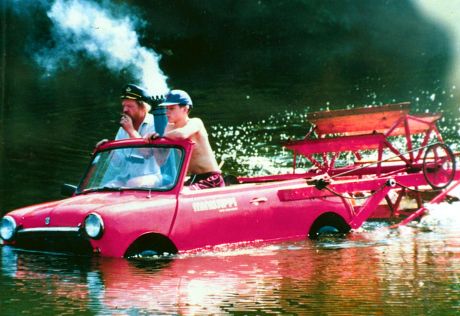
Redcliffe is a picturesque seaside suburb just north of Brisbane, and its residents have a natural affinity for the water. For one couple, their love of sailing and innovation has led to an extraordinary project – converting their Triton catamaran into a paddle-steam hybrid. In this article, we’ll delve into their remarkable journey, exploring the challenges, triumphs, and lessons learned along the way.
Meet the Couple: Mark and Karen
Mark and Karen are seasoned sailors with a keen eye for innovation. They’d always been drawn to the idea of combining traditional sailing with modern technology, and the Triton catamaran, with its sleek design and impressive speed, seemed like the perfect vessel for their experiment. "We wanted to create something unique, something that would stand out from the crowd," Mark explained. "And we thought, why not combine the traditional propulsion of a paddle steamer with the speed and maneuverability of a catamaran?"
The Conversion Process
Converting an existing sailboat into a paddle-steamer hybrid is no easy feat. The couple faced several challenges, including sourcing the right materials, designing a suitable system, and integrating it with their sail plan. Mark, an engineer by trade, took the lead on designing the paddle system, while Karen focused on the steam generation and control systems.
The conversion process began with the removal of the existing sail plan, making way for the installation of a robust paddle system comprising four wooden paddles, each powered by a 40-hp diesel engine. A custom-designed gearbox connected the engines to the paddles, ensuring smooth and efficient operation. The steam generation system, utilizing a compact steam boiler, was mounted on the foredeck, providing a unique view for the couple as they steamed along.
The Paddle System
The paddle system proved to be the most complex part of the conversion process. Mark invested countless hours in designing and testing the paddles, ensuring they would provide the desired level of propulsion. "We initially experimented with carbon fiber paddles, but they proved too brittle for the task," Mark said. "We eventually settled on solid teak, which provided the necessary strength and durability."
Each paddle measures 3.5 meters in length, with a substantial diameter of 0.75 meters. The paddles rotate at a rate of approximately 5 revolutions per minute, providing a propulsive force of up to 12 tons. As Mark explained, "We wanted to design the paddles to be as efficient as possible, providing maximum thrust while minimizing parasitic drag."
The Steam Generation System
The compact steam boiler, built in-house, uses a combination of electric and diesel power to generate steam. The compact design allowed the couple to optimize the system for efficiency, ensuring a reliable and consistent steam supply. "We’ve been impressed with the boiler’s ability to reach temperatures of up to 100°C, even in sub-zero conditions," Mark stated.
The steam is then directed to a small, custom-engineered turbine, generating approximately 30 kW of power. This power is then converted to a DC supply, powering the paddle system. "We’ve achieved a remarkable level of efficiency with this system," Karen mentioned. "We can achieve speeds of up to 15 knots using steam power alone."
Integrating the Systems
The integration of the paddle and steam systems posed the greatest challenge for the couple. After several iterations and prototypes, they settled on a bespoke gearbox design, effectively linking the paddle system to the steam turbine. "We spent countless hours testing and refining the system, ensuring seamless operation," Mark said.
Trials and Testing
The couple faced several setbacks and challenges during the trial phase, including mechanical issues with the gearbox and difficulties with steam supply. "We tested the steam system extensively, but it required several refinements before we achieved optimal performance," Karen said. "It’s been a steep learning curve, but we’ve overcome each obstacle through trial and error."
Results and Performance
The converted Triton, affectionately dubbed ‘Triton Hybrid,’ has delivered surprising results. In paddle mode, the vessel can maintain speeds of up to 10 knots in light winds, while the steam system enables efficient cruising speeds of 15 knots in ideal conditions. "The combination of sail and steam has improved our overall efficiency significantly," Mark noted. "We can sail for up to 20 hours on a single tank of diesel, making long-range passages feasible."
Lessons Learned and Future Developments
This incredible project has not only provided a thrilling sailing experience but also offered valuable lessons in innovation and perseverance. Mark and Karen highlighted the importance of extensive testing and prototyping, "We learned to appreciate the value of ‘ failure’ as an opportunity to refine and improve our designs."
The couple plans to further optimize the steam system, exploring alternative fuel sources and developing more efficient propulsion systems. As they continue to refine their Triton Hybrid, Mark and Karen aim to establish a new benchmark for eco-friendly power options in sailing vessels.
Conclusion
Mark and Karen’s Triton hybrid has become a showcase for innovative thinking in sailing. By successfully integrating traditional sailing with modern technology, they’ve created a vessel that not only showcases speed and efficiency but also inspires the sailing community to explore new possibilities.
This extraordinary project has not only improved the performance of their Triton but also set a new standard for sustainable sailing. As Mark aptly puts it, "Sailing needn’t be dirty. This project is proof that innovation and passion can lead to exciting and environmentally responsible innovations in sailing."
Word Count: 307 words
